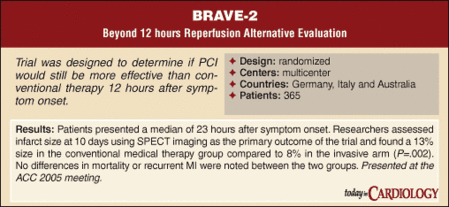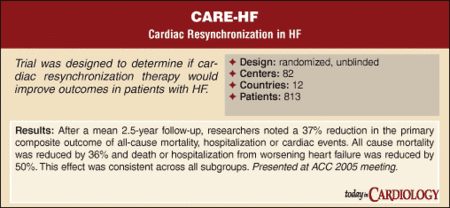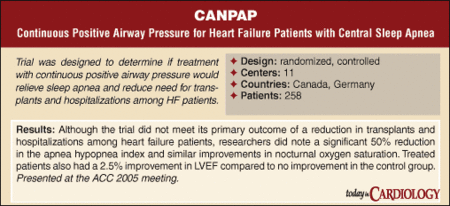Late-breaking clinical trials at the ACC Scientific Session highlight HF, PCI, drug trials
These late-breaking clinical trials were all presented at the American College of Cardiology Scientific Session 2005 held in Orlando. See the April and May 2005 issues of Cardiology Today for other news from this meeting.
Stand-alone percutaneous myoblast transplantation feasible
Percutaneous skeletal myoblast injection is feasible as a stand-alone procedure in patients with post-myocardial infarction heart failure, according to a study presented here.
Patrick Serruys, MD, professor of interventional cardiology at the University Hospital Rotterdam, presented results from a pilot feasibility investigation, which also gave some hints as to the potential efficacy of the therapy.
The 22 patients enrolled in the trial had an MI about six years prior and mean left ventricular ejection fraction of 34.4%. After arrhythmia events were noted in some patients early in the study, the data and safety monitoring board recommended implantable cardioverter defibrillators for a majority of patients.
Myoblast cells were cultured for a median of 17 days and had a high rate of viability and potency when injected.
Ejection fraction was increased from 34.4% at baseline to 36.6% at 12 months. End diastolic volume was reduced from 238 ml to 219 ml, a difference that was not statistically significant. End systolic volume decreased from 158 ml to 143 ml at 12 months, which was also not significant.
Wall motion score index improved from 3.04 at baseline to 2.75 at 12 months, which was barely significant (P=.049). New York Heart Association functional class had to be >2 for enrollment, and by the end of the trial it had reached a mean of 1.8.
Serruys said future randomized trials should focus on the occurrence of arrhythmia that was noted in this study.
For more information:
- Serruys PW. Myocardial repair by percutaneous cell transplantation of autologous skeletal myoblast as a stand alone procedure in post myocardial infarction chronic heart failure patients.
PG-116800 ineffective at preventing left ventricular remodeling
Treatment with the matrix metalloproteinase inhibitor PG-116800 following acute myocardial infarction was ineffective at preventing left ventricular remodeling.
“This initial finding should not prevent further study of other agents aimed at this therapeutic target,” W. Douglas Weaver, MD, head of the cardiology division at Henry Ford Hospital in Detroit, said. “Our understanding of the predictors and determinants of LV remodeling post MI is still rudimentary.”
Weaver and colleagues enrolled 253 patients with ST elevation MI, and randomized them to receive PG-116800 twice a day for 90 days or placebo. Patients could be excluded if they had a prior history of heart failure, a known abnormal ejection fraction, or severe co-morbid conditions that would likely cause death at 90 days.
The mean age of the cohort was 60 years. Mean time from MI diagnosis to first dose of PG-116800 was about 48 hours in both groups, 80% had an anterior MI and 90% had been treated with PCI.
Mean left ventricular end diastolic volume was 63 cc in the treatment group and 61 cc in the control group at baseline. Although this increased by about 5 cc in each group at 30 days, the difference was not statistically significant.
Weaver said the drug was well tolerated with no significant difference in adverse events or musculoskeletal complications between the two groups.
For more information:
- Weaver WD, Armstrong PW, Theroux P, et al. Effects of PG-116800, a matrix metalloproteinase inhibitor to prevent left ventricular remodeling after acute myocardial infarction.
Exercise time not increased by AGENT-3: Ad5FGF-4
Intracoronary Ad5FGF-4 did not increase exercise time compared to placebo in a randomized, controlled trial.
Timothy D. Henry, MD, Minneapolis Heart Institute, said pre-specified subgroup analyses showed some benefit, which provides a hypothesis for future testing. A trend toward improvements in angina class was noted.
Henry presented the results of AGENT-3, which tested the efficacy of Ad5FGF-4 (Berlex), an E1-deleted type 5 adenovirus encoding the human angiogenic FGF-4 gene, among 416 patients with stable angina who were not in immediate need of CABG or PCI.
Patients were randomized to placebo or either low dose (1x109 virus particles) or high dose (1x1010 virus particles) Ad5FGF-4. The mean age of the cohort was 62 years. About 44% had congestive HF, 40% had diabetes and 10% were current smokers. All patients had to be taking antiangina therapy and 90% were assigned at least two agents.
Researchers assessed treadmill exercise time as a primary outcome. Improvements were noted at four weeks (40 seconds), 12 weeks (70 to 80 seconds) and at six months (80 to 100 seconds), but there was no difference among the three groups. A subgroup analysis showed patients older than 55 with an exercise time of <300 seconds at baseline showed significant improvements in exercise time in the treatment group, primarily due to a dampening of the placebo effect.
Angina improvement of >two classes was noted in 12% of the placebo group, 16% of the low-dose group and 18% of the high-dose group, but this was not statistically significant.
Ad5FGF-4 was well-tolerated with no difference in cancer, MI or other adverse events.
For more information:
- Henry TD, Grine C, Dib N, et al. Agent 3 Final Results.
BRAVE-2: percutaneous intervention still effective after 12 hours
Percutaneous intervention was still more effective than conventional medical therapy among patients who were treated at least 12 hours after symptom onset.
Adnan Kastrati, MD, Deutsches Herzzentrum in Munich, said the findings of the BRAVE-2 (Beyond 12 hours Reperfusion Alternative Evaluation) trial, should be considered when guidelines are reassessed.
“A large proportion of patients with acute myocardial infarction present after 12 hours of symptom onset,” Kastrati said.
In this multicenter study, investigators enrolled 365 patients who had presented a median of 23 hours after symptom onset. The mean age of the patient cohort was 66 and 26% were women. Diabetes was present in 24% of the cohort, 37% had anterior MI, and 70% of the patients had a collateral flow grade of zero.
All patients were treated with clopidogrel (Plavix, Bristol-Myers Squibb), aspirin, or heparin upon enrollment before being randomized to continued conventional medical therapy or an angiography followed by percutaneous intervention with abciximab (ReoPro, Lilly).
Percutaneous intervention had a high rate of procedural success. At baseline 57% had TIMI 0 or 1 flow, but after the intervention 87% had TIMI 3.
Researchers assessed infarct size at 10 days using SPECT imaging as the primary outcome of the trial and found a 13% size in the conventional medical therapy group compared to 8% in the invasive arm (P=.002).
No differences in mortality or recurrent MI were noted between the two groups.

For more information:
- Schoemig A, Mehilli J, Antoniucci D, et al. A multicenter, randomized trial assessing the value of mechanical reperfusion in patients with acute myocardial infarction presenting >12 hours from onset of symptoms.
CACAF: catheter ablation effective in treating atrial fibrillation
A single session of catheter ablation was more effective at preventing atrial fibrillation than antiarrhythmic drug therapy.
Emanuele Bertaglia, MD, Ospedale Civile di Mirano in Italy, presented the results of the CACAF (Catheter Ablation for the Cure of Atrial Fibrillation) study. CACAF was the first randomized trial of the procedure that had previously been shown effective in observational studies.
Researchers enrolled 137 patients with paroxysmal or persistent atrial fibrillation who had already failed antiarrhythmic drug therapy. First atrial fibrillation diagnosis had to be at least six months prior to enrollment.
Patients were randomized to catheter ablation therapy or antiarrhythmic drug therapy.
The mean age of the cohort was about 62 years. About 60% of the patients had paroxysmal atrial fibrillation. Although the cohort was well balanced overall, the history of atrial fibrillation was longer in the control group at 7.1 years compared to 5.1 years in the treatment group.
The primary outcome of CACAF was atrial fibrillation-free survival. Atrial fibrillation events were reported in 91% of the control group and 44% of the catheter ablation group at 12 months (HR=3.2).
Following the assessment of the primary outcome, patients who had not experienced atrial fibrillation were randomized to have their drug therapy stopped or continued. The rate of atrial fibrillation recurrence was unaffected by the presence of drug treatment.
For more information:
- Bertaglia E, Stabile G, Senatore G, et al. A prospective, randomized, and controlled study on effect of catheter ablation for the cure of atrial fibrillation study (CACAFStudy).
CARE HF: Cardiac resynchronization therapy effective among HF patients
Cardiac resynchronization therapy significantly reduced mortality and hospitalizations among patients with New York Heart Association Class III to IV heart failure.
John Cleland, MD, University of Hull in England, who presented the results of the CARE-HF (Cardiac Resynchronization in Heart Failure) trial, said about 50% of patients with advanced HF will also have cardiac dysynchrony.
CARE-HF researchers enrolled 813 patients from 82 centers in 12 countries and randomized them to either treatment with a cardiac resynchronization device (InSync or InSync III, Medtronic) or control.
The mean age of the patients was 67 years. Average heart rate was 70 bpm, QRS duration was 160 ms, and mean left ventricular ejection fraction was 25%. About 95% of the patients were taking ACE inhibitors, 72% were taking beta-blockers and 45% were on loop diuretics.
After a mean follow-up of 2.5 years, researchers assessed a primary composite outcome of all-cause mortality, hospitalizations, or any cardiovascular event. Device-treated patients had a 37% risk reduction; an effect which was maintained in all subgroups. All-cause mortality was reduced by 36% and death or hospitalization from worsening heart failure was reduced by 50%.
“Cardiac resynchronization should be considered part of routine therapy for this patient population,” Cleland said.

For more information:
- Cleland JG, Tavazzi L, Daubert JC, et al. The cardiac resynchronization heart failure study (CARE-HF): a randomized study of the effects of optimal pharmacological therapy alone or combined with cardiac resynchronization in patients with advanced heart failure and cardiac dysynchrony.
Myoblast transplantation in CABG patients feasible, safe
Surgical autologous myoblast transplantation within an infarcted myocardium in patients undergoing coronary artery bypass grafting is feasible and safe.
Nabil Dib, MD, director of cardiovascular research at the Arizona Heart Hospital, presented three-year data on a safety and feasibility trial among 24 patients. The mean age of the patients was 55.2 years and 23 were men. All patients had a previous MI, mean ejection fraction was 28%, mean NYHA Class was 2.1, and 14 patients had ventricular arrhythmias.
Myoblast transplantation is conducted by extracting skeletal myoblasts, expanding them in a cell laboratory and transplanting them into the scar tissue. The first 12 patients in the study received escalating doses from 10 million to 300 million cells with the remaining 12 patients receiving 300 million cells.
Researchers had a 100% success rate in cell delivery. Viability rate of the cells was 92% and the purity was 79%.
PET scans at six months showed the cells were viable. Researchers also noted improvement in New York Heart Association Class and heart function.
Dib said further trials on left ventricular function are warranted. His institution would be conducting two trials on medical therapy vs. myoblast transplant.
For more information:
- Dib N, Kereiakes D, McCarthy P, et al. Three-year follow-up of the feasibility and safety of autologous myoblast transplantation for ischemic cardiomyopathy in patients undergoing coronary artery bypass grafting.
Buflomedil reduced clinical events
Patients with limb claudication who were treated with buflomedil (Fonzylane, Cephalon) had significant reductions in lower limb amputations, cardiovascular death and total death.
Buflomedil is a vasodilator that has been shown to decrease symptoms in patients with peripheral arterial disease in small studies where treadmill testing was a primary outcome. The trial presented by Alain Leizorovicz, MD, Unité de Pharmacologie Clinique Université Claude Bernard in France, assessed the agent’s effect on clinical outcomes.
Researchers enrolled 2,078 patients and randomized them to either buflomedil or placebo. The mean age of the patients was 61.4, and 82.5% were men. Coronary artery disease was present in 45% of patients, 7.3% had had a previous stroke, and diabetes was present in 15.7%.
At the end of a three-year follow-up, researchers assessed a primary composite outcome of surgery, angioplasty or the need for hospitalization due to intermediate claudication; fatal or nonfatal cardiovascular complications; or amputation. Treated patients reported 95 events while placebo patients had 128 events, which was a statistically significant 26% risk reduction.
Claudication rates improved with buflomedil, and safety outcomes were similar between the two groups.
For more information:
- Leizorovicz A. Long-term treatment with a vasoactive agent (buflomedil) prevents clinically significant events in peripheral arterial occlusive disease patients.
CANPAP: Continuous positive airway pressure relieves sleep apnea in heart failure patients
Continuous positive airway pressure was effective in relieving symptoms of sleep apnea and improving heart function in heart failure patients, but the trial failed to achieve its primary outcome of improving transplant and hospitalization rates.
Douglas Bradley, MD, Toronto General Hospital of the University Health Network, presented results of the CANPAP (Continuous Positive Airway Pressure for Heart Failure Patients with Central Sleep Apnea) trial.
CANPAP was originally designed to determine if treatment with continuous positive airway pressure would reduce need for heart transplants and hospitalization, but the event rate was far too low and the trial was stopped early.
Researchers enrolled 258 patients, rather than the planned 408, and randomized them to airway pressure treatment or control. The mean age of the patients was 63 years; they were overweight, but not obese. Patients slept for just over five hours a night and had about 40 episodes of apnea per hour.
After a mean follow-up of two to six years, researchers noted a 50% reduction in the apnea hypopnea index and similar improvements in nocturnal oxygen saturation. Treated patients also had a 2.5% improvement in left ventricular ejection fraction, a 20 meter increase in six-minute walking distance and a reduction in plasma norepinephrine levels compared to no improvement in the control group.

For more information:
- Bradley TD, Logan AG, Floras JS. Continuous positive airway pressure for heart failure patients with central sleep apnea (CANPAP).
PEECH: EECP improves exercise duration
EECP improved exercise duration and other measures of heart failure in a trial reported here.
EECP utilizes a series of inflatable cuffs to rapidly inflate under high pressure at the onset of diastole and rapidly deflate at the onset of systole to replicate the hemodynamic properties of intraaortic counterpulsation. Treatment is typically administered in 35 one-hour treatment sessions.
For the PEECH (Prospective Evaluation of EECP in Congestive Heart Failure) study, which Arthur Feldman, MD, Jefferson University Hospital in Philadelphia, presented, researchers screened about 800 patients and randomized 187 to treatment or placebo.
The mean age of the patients 62 years, 72% were men and 76% were white. About 65% of the patients had HF of ischemic origins; mean ejection fraction was 26%. Patients were optimally treated with more than 90% assigned beta-blockers, ACE inhibitors or angiotensin II receptor blockers.
After a six-month follow-up, researchers assessed a primary outcome of rate of patients who achieved .60 seconds of improvement in exercise duration, an effect that was seen in 35.4% of the treatment group compared to 25.3% of controls (P=.016).
Consistent with this finding, there were significant improvements in New York Heart Association functional class and quality of life, but no improvements in the co-primary endpoint of change in peak VO2.
For more information:
- Feldman A, Silver MA, de Lame PA, et al. Prospective evaluation of EECP in congestive heart failure: the PEECH trial.
